Research interests
 |
The overarching theme of our research is analysis, design, and control of high-performance and robust cyber-physical networks. In the Siami lab, we apply tools and techniques from control theory, optimization, graph theory, game theory, machine learning (ML), reinforcement learning (RL), and applied probability theory to control and solve decision-making problems in several application areas: cloud-based services, smart energy systems, networks of autonomous vehicles, and biological networks.
 |
Our research focuses on graph dependent performance limitations in large-scale interconnected dynamical networks. The primary focus is on revealing foundational role of underlying structure/graph of large-scale dynamical networks. The underlying structure of a network depends on coupling structure among the subsystems, which are usually imposed by physical laws or global objectives. Our research results are applicable to several application areas: financial networks, smart energy networks, networks of autonomous vehicles, and biological networks. |
Sparse Sensor and Actuator Selection in Cyber-physical networks:
Given the increasingly large-scale nature of the problems presented by infrastructure networks (e.g., water and power networks), multi-robot systems, and the study of the human connectome, it is imperative to be able to estimate the overall state of the given system or to control the system using a small subset of available features (e.g., PMUs, camera sensors, EEG sensors, or data from 3-D mapping and radar technology). When the number of the state is large, finding the optimal yet low cardinality subset of features is like finding a needle in a haystack: the problem is computationally difficult and provably NP-hard. Previous studies have been mainly focused on solving the optimal feature selection problem using the greedy heuristic, as an approximation of the corresponding sparse-subset selection problem. While these results attempt to find approximation algorithms for finding the best sparse subset, our focus is to gain new fundamental insights into approximating various performance metrics compared to the case when all features are chosen. We adopt the machinery developed for the Kadison-Singer Conjecture to find a sparse subset of actuators/sensors to improve the controllability/ observability performance. We develop a framework for a sparse actuator/sensor schedule and show that by carefully designing a time-varying feature selection strategy, one can choose on average a constant number of relevant actuators/sensors at each time, to ensure proper control/monitoring of a linear dynamical system.
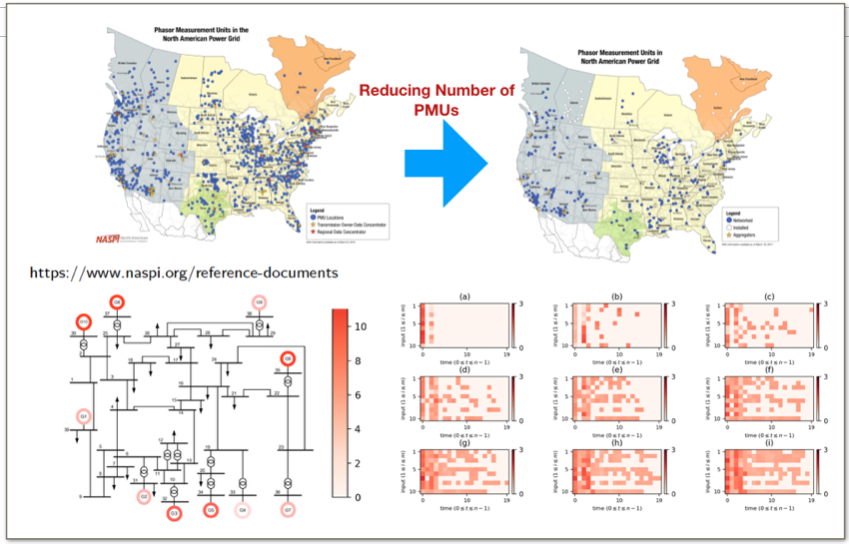 |
Application in Epidemics: Regulation for “Vaccine Tourism” to Mitigate Waves of Pandemic
Another aspect of an epidemic outbreak that requires more attention is vaccine tourism. When vaccination becomes available for the first time, it motivates traveling to the centers offering it which results in the vaccine tourism phenomenon. In the case of COVID-19 for instance, it is predicted that the first successful country in developing the vaccination will attract many tourists, at least until the vaccination resources are well distributed. With the vaccine distribution facing several challenges such as keeping vaccines at subzero temperatures, having low efficacy rate, producing limited dozes, etc, air transportation to the country offering the vaccine will probably be continued for several months. Therefore, most probably, with the vaccine tourism comes a new wave of infection raise which requires a near-optimal and fast traffic volume control to mitigate its adverse consequences. The offered policies in this study can be generalized to meet the requirements for a safe and robust traffic control in the case of releasing a vaccination.
 |
Meta-population networks of 15 United States airport hubs with
their normal, optimal, and robust traffic volume, respectively [link]. |
Centrality-Based Traffic Restriction in Delayed Epidemic Networks with A. Darabi
A. Darabi, and M. Siami, "Centrality in Epidemic Networks with Time-Delay: A Decision- Support Framework for Epidemic Containment," American Control Conference, New Orleans, Louisiana, USA, 2021.
Fighting the Virus is Like Fighting A War [news link]
Application in Robotics and controlling Self-driving cars
 |
Goal: Minimize Robot/RaceCar's deviation from desired trajectory:
|
Deterministic and Randomized Actuator Scheduling With Guaranteed Performance with A. Jadbabaie and A. Olshevsky
Rapid Autonomous Complex-Environment Competing Ackermanndrive Robotics is featured in MIT’s Spectrum Magazine
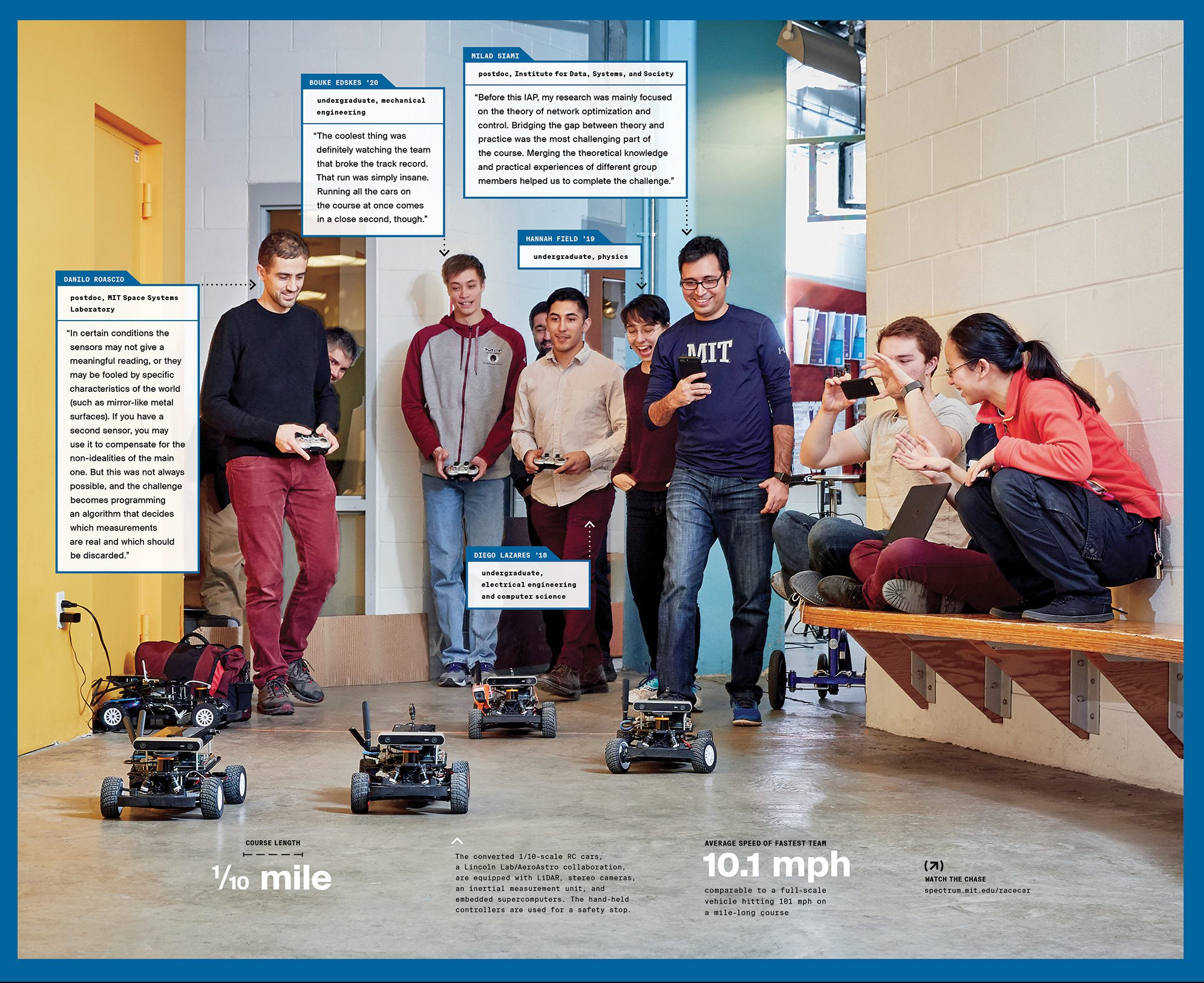 |
During the Independent Activities Period (IAP-2018) at MIT, my group (shag!) and I implemented and tested our perception and planning algorithms for self-driving cars that can quickly navigate through complex environments video.
Here is a fun video from an informal mini self-driving car competition; our perception and planning algorithms run on the leading mini self-driving robot. This is a powerful platform for robotics research and education based on the open-source MIT-RACECAR.
M. Siami, L. Carlone, and A. Jadbabaie, "Sparse Visual Attention Mechanism With Guaranteed Performance Bounds," Working Paper. Video link
Application in Smart Power Networks
 |
Goal: Stabilize power grid using HVDC generators; place PMUs that make the grid observable
|
Deterministic and Randomized Actuator Scheduling With Guaranteed Performance with A. Jadbabaie and A. Olshevsky
Cloud-based Services and System Throttlers:
 |
Internet-scale applications present several technical challenges. In this project, we investigate the performance analysis and synthesis of distributed system throttlers (DST). A throttler is a mechanism that limits the flow rate of incoming metrics, e.g., bytes per second, network bandwidth usage, capacity, traffic, etc. This can be used to protect a service’s backend/clients from getting overloaded, or to reduce the effects of uncertainties in demand for shared services. We study performance deterioration of DSTs subject to demand uncertainty. We then consider network synthesis problems that aim to improve the performance of noisy DSTs via communication link modifications as well as server update cycle modifications.
|
Structural Analysis and Optimal Design of Distributed System Throttlers IEEE Transactions on Automatic Control
https://ai.google/research/pubs/pub46233 is featured in Google AI
Centrality Measures in Dynamical Networks
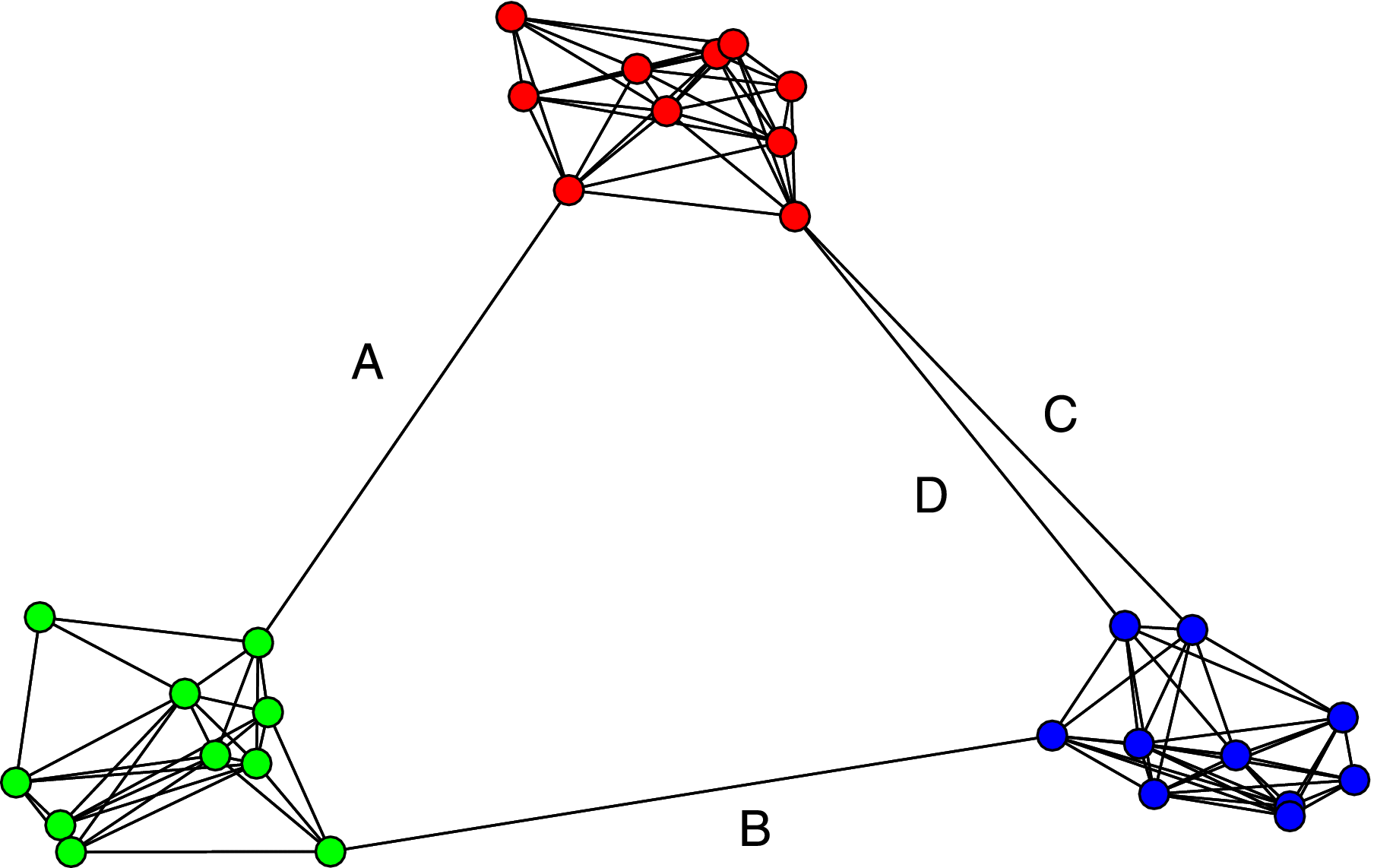 |
We propose new insights into the network centrality based
not only on the network graph, but also on a more structured model of network uncertainties. I investigate several structures for noise input and provide engineering insights on how each uncertainty structure can be relevant in real world settings. Then, a new centrality index is defined in order to assess the influence of each agent or link on the network performance. Our results assert that agents or links can be ranked according to this centrality index, and their rank can drastically change from the lowest to the highest, or vice versa, depending on the noise structure. This fact hints at emergence of fundamental tradeoffs on network centrality in the presence of multiple concurrent
network uncertainties with different structures. We also build on our results and extend them to consider the role of both time-delay and uncertainty structure in the centrality ranking. |
M. Siami, S. Bolouki, B. Bamieh and N. Motee, "Centrality measures in linear consensus networks with structured network uncertainties, " IEEE Transactions on Control of Network Systems, Volume 5, Issue 3, 2018, Pages: 924-934.
Y. Ghaedsharaf, M. Siami, and N. Motee, ”Performance Improvement in Noisy Linear Consensus Networks with Time-Delay,” IEEE Transactions on Automatic Control, Vol. 64, Issue 6, 2019. To Appear.
Y. Ghaedsharaf, M. Siami, C. Somarakis, and N. Motee, "Interplay Between Performance and Communication Delay in Noisy Linear Consensus Network," In Proceedings of European Control Conference, Aalborg, Denmark, 2016.
Network Synthesis for Performance Enhancement
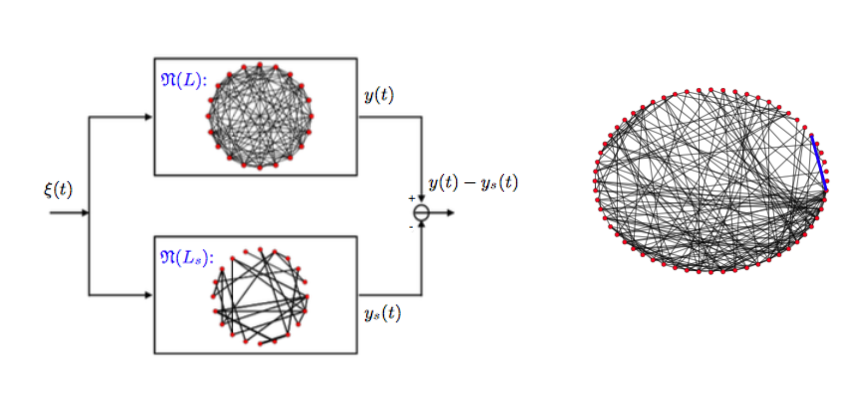 |
A proper abstraction of a large-scale linear consensus network with a dense coupling graph is one whose number of coupling links is proportional to its number of subsystems and its performance is comparable to the original network. Optimal design problems for an abstracted network are more amenable to efficient optimization algorithms. From the implementation point of view, maintaining such networks are usually more favorable and cost effective due to their reduced communication requirements across a network. Therefore, approximating a given dense linear consensus network by a suitable abstract network is an important analysis and synthesis problem. In this paper, we develop a framework to compute an abstraction of a given large-scale linear consensus network with guaranteed performance bounds using a nearly linear time algorithm. First, the existence of abstractions of a given network is proven. Then, we present an efficient and fast algorithm for computing a proper abstraction of a given network. Finally, we illustrate the effectiveness of our theoretical findings via several numerical simulations. |
M. Siami and N. Motee, "Network Abstraction with Guaranteed Performance Bounds," IEEE Transactions on Automatic Control, Vol. 63, Issue 10, 2018, Pages: 3301-3316. [arXiv]
M. Siami and N. Motee, "Growing Linear Dynamical Networks Endowed by Spectral Systemic Performance Measures," IEEE Transactions on Automatic Control, Volume 63, Issue 7, 2018, Pages: 2091-2106. [arXiv]
"Architecting better connectivity" is featured in Lehigh's News [Paper Award]
On the Signed Edge Domination Number of Graphs
 |
In 2006, Xu conjectured that: for any 2-connected graph G of order n (n ≥ 2), its signed edge domination number is greater than or equal to one. In this project, we show that this conjecture is not true. More precisely, we show that for any positive integer m, there exists an m-connected graph G such that its signed edge domination number is less than or equal to − m/6 |V (G)|. Also for every two natural numbers m and n, we determine the signed edge domination number of the complete bipartite graph with part sizes m and n. |
* S. Akbari, S. Bolouki, P. Hatami and M. Siami, "The Signed Edge Domination Number of Graphs," Discrete Mathematics, Volume 309, Issue 3, 2009, Pages: 587-594.
[* Authors appear in alphabetical order.]My Erdos number is 3 (Hatami-Behzad-Erdos, or Akbari-Kostochka-Erdos)
Performance Analysis and Tradeoffs in Complex Dynamical Networks
The recent interest in understanding fundamental limitations of feedback in complex interconnected dynamical networks from biological systems and physics to engineering and economics has created a paradigm shift in the way systems are analyzed, designed, and built. Typical examples of such complex networks include metabolic pathways, vehicular platoons, arrays of micro-mirrors, micro-cantilevers, and smart power grids. These systems are diverse in their detailed physical behavior. However, they share an important common feature that all of them consist of an interconnection of a large number of systems.
 |
We develop some basic principles to investigate performance deterioration of dynamical networks subject to external disturbances. First, we propose a graph-theoretic methodology to relate structural specifications of the coupling graph of a linear consensus network to its performance measure. Moreover, for this class of linear consensus networks, we introduce new insights into the network centrality based not only on the network graph but also on a more structured model of network uncertainties. Then, for the class of generic linear networks, we show that the H2-norm, as a performance measure, can be tightly bounded from below and above by some spectral functions of state and output matrices of the system. Finally, we study nonlinear autocatalytic networks and exploit their structural properties to characterize their existing hard limits and essential tradeoffs. |
M. Siami and N. Motee, "Network Abstraction with Guaranteed Performance Bounds," IEEE Transactions on Automatic Control, Vol. 63, Issue 10, 2018, Pages: 3301-3316. [arXiv]
M. Siami and N. Motee, "Growing Linear Dynamical Networks Endowed by Spectral Systemic Performance Measures," IEEE Transactions on Automatic Control, Volume 63, Issue 7, 2018, Pages: 2091-2106. [arXiv]
M. Siami, J. Skaf, "Structural Analysis and Optimal Design of Distributed System Throttlers," IEEE Transactions on Automatic Control, Volume 63, Issue 2, 2018, Pages: 540-547. [arXiv]
M. Siami, and N. Motee, "Fundamental Limits and Tradeoffs on Disturbance Propagation in Linear Dynamical Networks," IEEE Transactions on Automatic Control, Volume 61, Issue 12, 2016, Pages: 4055-4062. [arXiv]
M. Siami and N. Motee, "New Bounds on H_2-Norm of Noisy Linear Dynamical Networks," Automatica, Volume 53, Issue 5, 2017, Pages: 305-312. [arXiv]
M. Siami, S. Bolouki, B. Bamieh and N. Motee, "Centrality measures in linear consensus networks with structured network uncertainties, " IEEE Transactions on Control of Network Systems, Volume 5, Issue 3, 2018, Pages: 924-934.
Application in Biological Networks
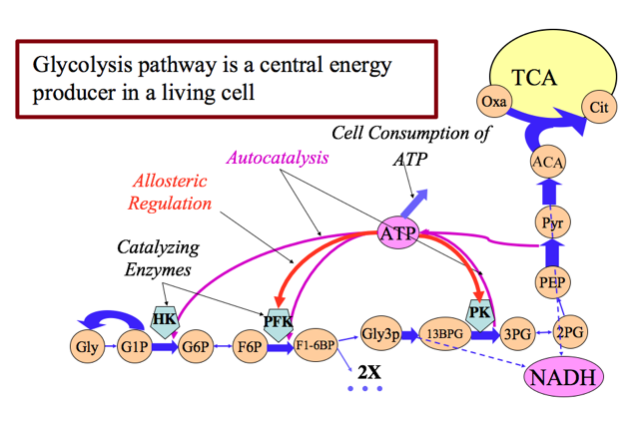 |
The class of dynamical networks with autocatalytic structures can be found in most of the planet’s cells from bacteria to human, engineered, and economic systems. In an interconnected control system with autocatalytic structure, the system’s product (output) is necessary to power and catalyze its own production. There has been some recent interest to study models of the glycolysis pathway which is an example of an autocatalytic dynamical network in biology that generates adenosine triphospate (ATP) which is the cell’s energy currency and is consumed by different mechanisms in the cell. Other examples of autocatalytic networks include engineered power grids whose machineries are maintained using their own energy product as well as financial systems which operate based on generating monetary profits by investing money in the market. Recent results show that there can be severe theoretical hard limits on the resulting performance and robustness in autocatalytic dynamical networks. It is shown that the consequence of such tradeoffs stems from the autocatalytic structure of the system. |
M. Siami, N. Motee, G. Buzi, B. Bamieh, M. Khammash, and J.C. Doyle, "Fundamental Limits and Tradeoffs in Autocatalytic Pathways," IEEE Transactions on Automatic Control, 2018, Accepted. [arXiv]
M. Siami and N. Motee, "Robustness and Performance Analysis of Cyclic Interconnected Dynamical Networks," In Proceedings of the SIAM Conference on Control and Its Application, San Diego, CA, USA, 2013.
Adaptive Networked Control with Noisy Communications
In this project, we consider a stabilization problem for uncertain plants over networks subject to packet loss and quantization via a direct adaptive control approach. Specifically, for a discrete-time linear time-invariant plant whose parameters are uncertain, we propose a design method for an adaptive controller and an input quantizer. The proposed framework is Lyapunov-based and guarantees Lyapunov stability in probability of the closed-loop system states and almost sure convergence of the plant states. Two results have been obtained corresponding to the situations where the controller is informed of packet losses or not by means of acknowledgement messages.
 |
M. Siami, T. Hayakawa, H. Ishii and K. Tsumura, "Adaptive quantized control for linear uncertain discrete-time systems over channels subject to packet loss," In Proceedings of the 49th IEEE Conference on Decision and Control, Atlanta, GA, USA, 2010.
Stability and Harmonic Analysis of Time-varying Dynamical Systems
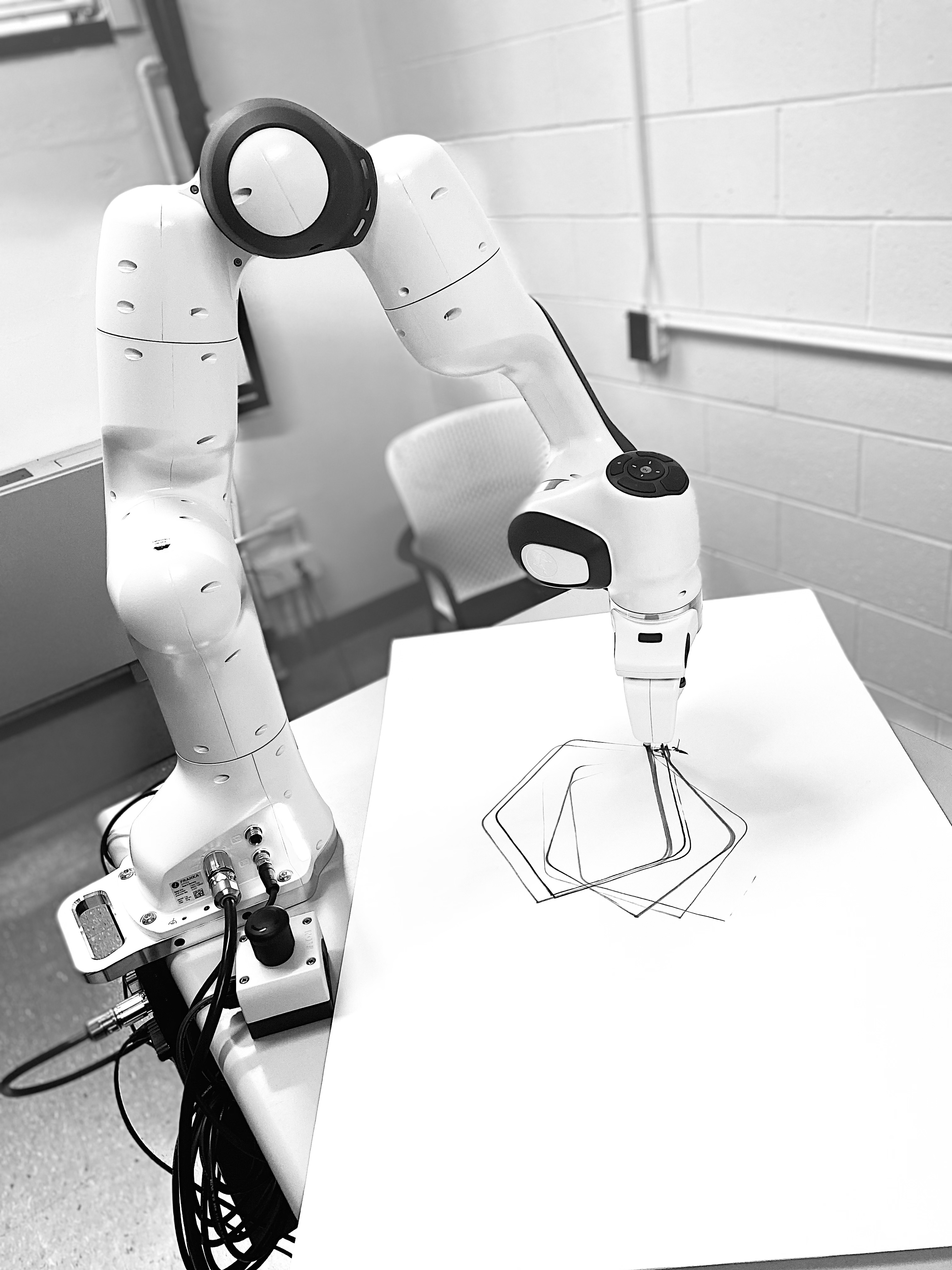 |
Fractional-order systems, widely regarded as an extension of integer-order systems, are those dynamical systems whose state space representations involve non-integer derivatives of the states. In this project, we investigated important problems regarding fractional-order systems, which are their stability analysis, oscillation analysis, and chaos control.
|
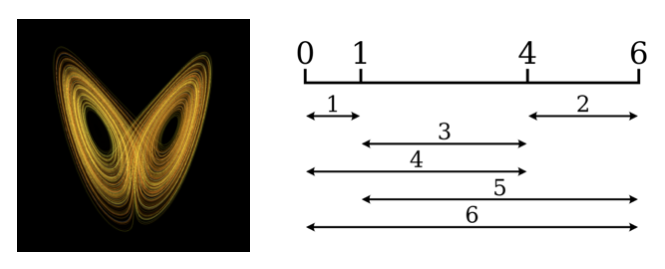 |
‘‘In mathematics, a Golomb ruler is a set of marks at integer positions along an imaginary ruler such that no two pairs of marks are the same distance apart.” —wiki |
M. Siami and M. S. Tavazoei, "Oscillations in Fractional Order LTI Systems: Harmonic Analysis and Further Results," Signal Processing, Volume 93, Issue 5, 2013, Pages 1243-1250.
M. Siami, M. S. Tavazoei and M. Haeri, "Stability Preservation Analysis in Direct Discretization of Fractional Order Transfer Functions," Signal Processing, Volume 91, Issue 3, 2011, Pages 508-512.
M. S. Tavazoei, M. Haeri M. Siami and S. Bolouki, "Maximum Number of Frequencies in Oscillations Generated by Fractional Order LTI Systems," IEEE Transactions on Signal Processing, Volume 58, Issue 8, 2010, Pages: 4003-4012.
M. S. Tavazoei, M. Haeri, M. Attari, S. Bolouki and M. Siami, "More Details on Analysis of Fractional-Order Van Der Pol Oscillator," Journal of Vibration and Control, Volume 15, 2009, Pages: 803-819.
M. S. Tavazoei, M. Haeri, S. Jafari, S. Bolouki and M. Siami, "Some Applications of Fractional Calculus in Suppression of Chaotic Oscillations," IEEE Transactions on Industrial Electronics, Volume 55, 2008, Pages 4094-4101.
M. S. Tavazoei, M. Haeri, S. Bolouki and M. Siami, "Stability Preservation Analysis for Frequency Based Methods in Numerical Simulation of Fractional Order Systems," SIAM Journal on Numerical Analysis, Volume 47, 2008, Pages 321-338.
M. S. Tavazoei, M. Haeri, S. Bolouki and M. Siami, "Using Fractional-Order Integrator to Control Chaos in Single-Input Chaotic Systems,” Nonlinear Dynamics, Volume 55, Number 1-2, 2009, Pages 179-190.
M.Sc. Thesis, "Analysis of Oscillations in Linear Fractional-Order Systems," Sharif University of Technology, 2012. Advisor: Prof. M. S. Tavazoei
B.Sc. Thesis, "Analysis in Methods of Finding Approximation of Fractional-Order Systems," Sharif University of Technology, 2009. Advisor: Prof. M. Haeri
Competitive Contagion with Sparse Seeding
This project studies a strategic model of marketing and product diffusion in social networks. We consider two firms offering substitutable products which can improve their market share by seeding the key individuals in the market. Consumers update their consumption level for each of the two products as the best response to the consumption of their neighbors in the previous period. This results in linear update dynamics for the product consumption. Each consumer receives externality from the consumption of each neighbor where the strength of the externality is higher for consumption of the products of the same firm. We represent the above setting as a duopoly game between the firms and introduce a novel framework that allows for sparse seeding to emerge as an equilibrium strategy. We then study the effect of the network structure on the optimal seeding strategies and the extent to which the strategies can be sparsified. In particular, we derive conditions under which near Nash equilibrium strategies can asymptotically lead to sparse seeding in large populations. The results are illustrated using a core-periphery network.
 |
S. Bolouki, R.P. Malhame, M. Siami and N. Motee. "Eminence Grise Coalitions: On the Shaping of Public Opinion," IEEE Transactions on Control of Network Systems, June 2017, Pages 133-145. [arXiv]
M. Siami, A. Ajorlou, and A. Jadbabaie, "Competitive Contagion with Spare Seeding,” The 8th IFACWorkshop on Distributed Estimation and Control in Networked Systems (NecSys19), Chicago, IL, 2019 [arXiv].
Disclaimer: Any photo from external source used in this page is courtesy of the link associated to it.